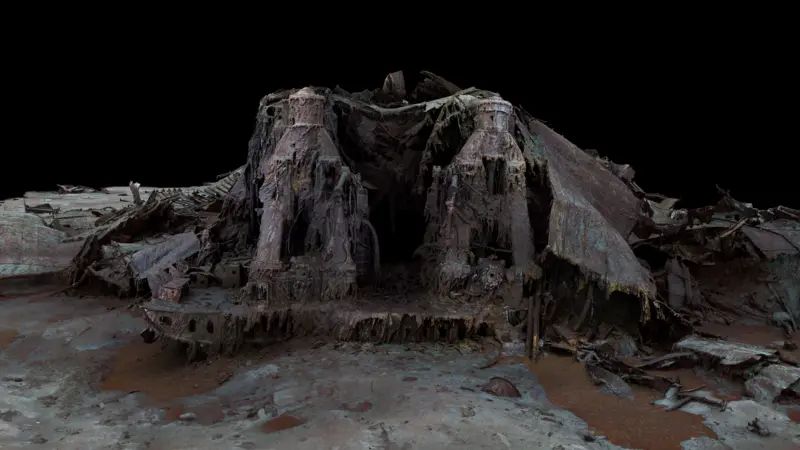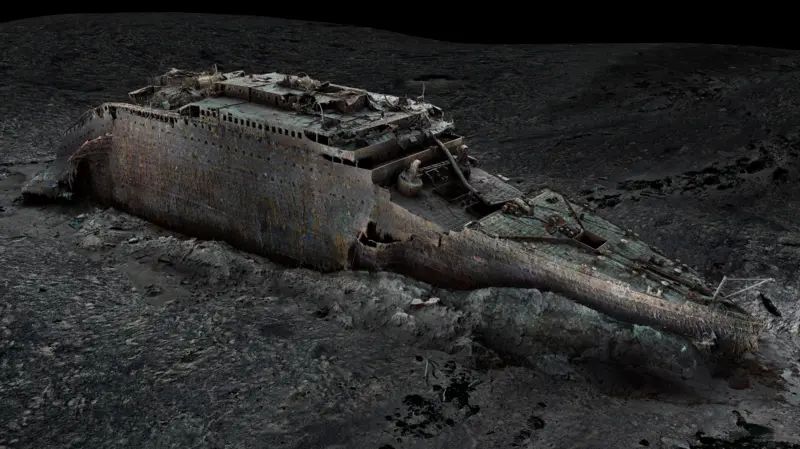A full-sized digital scan of the Titanic has revealed new, ground-breaking insights into the tragic vessel’s final hours.
The detailed 3D replica exposes the violence of the ship’s breakup and supports eyewitness accounts of desperate measures taken by its crew during the disaster.
The scan provides a comprehensive view of the wreck lying 3,800 meters below in the Atlantic. One remarkable finding is that the bow of the ship now sits upright on the seafloor—almost as if the ship were still on course—while the stern, found 600 meters away, is a mangled heap of metal. This contrast vividly illustrates the ship’s catastrophic breakup.
Using underwater robotics, more than 700,000 images were captured from every angle to create this “digital twin” of Titanic. The resulting model not only reproduces the ship’s physical structure but also details how it ripped in two after colliding with an iceberg in 1912—a disaster that cost approximately 1,500 lives.

One of the most striking discoveries is within the ship’s boiler room, visible at the rear of the bow where the Titanic broke apart. The scan confirms that some boilers exhibited a concave shape, indicating they were still active as the ship sank, keeping the lights on in defiance of the impending doom.
Eyewitness reports from survivors of the sinking mentioned the eerie presence of light moments before the ship plunged beneath the waves. The digital scan shows evidence of an open valve on the deck of the stern, a remnant of the heroic efforts by engineers who labored to maintain power as long as possible. Their actions, led by Joseph Bell, helped delay the darkness and chaos during the evacuation.
A computer simulation accompanying the scan also provides fresh perspectives on the disaster. Developed using Titanic’s blueprints, the simulation incorporated details about the ship’s speed and angle, suggesting that a series of puncture wounds—each roughly the size of an A4 sheet of paper—played a critical role in the vessel’s eventual sinking.
The simulation indicates that while the Titanic was designed to stay afloat even with four flooded compartments, damage spread across six compartments ultimately overwhelmed its structure. Small, elongated gashes allowed water to seep in gradually, compromising the ship’s ability to remain buoyant.
Professor Jeom-Kee Paik of University College London, who led the simulation research, explained that “advanced numerical algorithms” and supercomputing capabilities were used to reconstruct the sinking event. This high-tech approach is now offering a clearer understanding of how seemingly minor hull punctures contributed to the disaster.
The findings from the digital scan are likened to examining a crime scene—each piece of evidence must be considered in context. Titanic, as the last surviving witness of the catastrophe, continues to “tell its story” through these detailed images and simulations.
Despite the new information, certain aspects remain obscured. For instance, the lower section of the bow is hidden beneath sediment, preventing a complete view of all the damage sustained during the sinking.
The breakthrough provided by this digital scan opens new avenues for historians and maritime experts to study one of the most infamous disasters of the 20th century. As researchers continue to scrutinize the intricate details of the model, the enduring tragedy of the Titanic and the heroic final acts of its crew are given new life in the quest for understanding.

